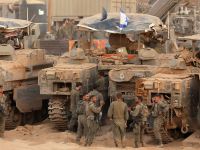A new collaborative graphic novel, “Meantime” draws on the talents of five illustrators from Syria, Lebanon and France to tell stories from the daily lives of Syrian refugees in Lebanon. The publication has been produced by international NGO Solidarites International (SOL), which works to supply Syrian refugees in Lebanon with fresh water, sanitation, and hygiene and shelter.
Supported by UNICEF and the European Civil Protection and Humanitarian Aid Operations (ECHO), SOL commissioned the illustrators to visit different settlements, apartments and shelters around Lebanon to meet Syrian refugees and record their stories.
“Solidarites International was originally a French organization so we had a French artist, a few Lebanese artists,” SOL Communications Manager Nasser Zawk told The Daily Star.
“We are talking about the Syrian crisis so we also had a Syrian artist onboard,” he added.
The book was originally published in March 2017, Zawk explained, but it’s hoped that distribution will be boosted with its exhibition alongside an audiovisual installation at the KED performance venue in Karantina.
The work, titled “Bukra Inshallah” (Hopefully Tomorrow), has been published in English, Arabic and French.
“A year after [its release] we saw that tomorrow came but the situation didn’t change,” Zawk said.
“Hence the exhibition. We are in ‘tomorrow’ but we are still in the status quo, nothing has changed,” he added.
In the present political climate, with many Lebanese wanting refugees to return to Syria, Zawk said that showing the graphic novel in a new exhibition was essential.
“Lately the Lebanese rhetoric about the return of Syrians has been crazy,” he said. “By doing an exhibition at this time, especially after the elections, is good to remind people of the real situation on the ground.
“Syria still faces obstacles,” Zawk said.
“The war is not over. Bombings have still been happening from January 2018 until now relentlessly.”
The book illustrates the daily challenges Syrian refugees face.
“We chose illustration because we thought it was the best way to take out the prejudice,” Zawk explained. “When you go to fictional characters, it gives a person a more open imagination.
“It was a way to tone everything down for people who are not as acquainted with the Syrian crisis.”
Although each story is personal, they all describe common struggles that a huge proportion of Syrian refugees face.
Almost all of the stories reference the strain many refugees face to financially support themselves and their families – due to the Lebanese state’s tough job restrictions on them, expensive residency permits and the high cost of living.
Many of the stories highlight children’s limited access to education and health care, which keeps a huge proportion of Syrian minors out of school and puts them at risk of life-threatening illnesses.
“Our Life in a Tent,” by Syrian comic artist and illustrator Diala Brisly, focuses on the relationship between men and women in Syrian refugee families.
After meeting many different families, Brisly created a fictional story based on real events.
Most striking is the shift in gender roles within the household, a direct result of the crisis.
In her story the husband, who had owned a company in Syria, finds he can only find work in the construction sector.
Continuously stopped and harassed by police, he is also unable to pass through checkpoints.
When his daughter falls ill and is rushed to hospital, he is forced to stay at home.
It is such restrictions that cause a shift in household gender roles.
Now, the mother bears the brunt of the responsibility.
Kamal Hakim’s “Aassoun Tower” also uses the example of a few Syrians living in a collective shelter to sketch the daily challenges Syrian refugees face.
The Aassoun Tower is located in Seer al-Dinnieh municipality, just outside Tripoli.
Combining snippets of stories from different people he met, Hakim weaves friendly and comical anecdotes in with the residents’ grave stories. Most poignant is the story of Ahmad, who describes the constant threat of fraudsters.
Representing themselves as NGO workers, they actually work for local mafias out to take advantage of the vulnerable refugees.
The story ends with Hakim emphasizing Lebanon and Syria’s “shared fate.”
Illustrating how, just 30 years ago, Lebanese citizens endured a situation as dire as that which Syrians face today, Hakim’s story reminds readers that the two peoples have a shared history of civil conflict and neighborly assistance.
Not all of the stories are disheartening.
“Where There is Life, There is Love,” by Lebanese illustrator Lena Merhej, shows how cultural traditions and generosity unite people.
The comic explores the lives of a number of different families housed in informal settlements in rural Akkar, north of Tripoli.
A memorable episode involves the wedding celebration of a refugee couple. In keeping with tradition, and despite their desperate situation, the whole community gathers to throw them a party.
Included in the exhibition is an audiovisual installation called “Memory Room,” which relays the memories of Syrian refugees through sound and snippets of videos.
“The audiovisual part of the exhibition,” Zawk said, seeks “to remind people that, no, Syria still faces obstacles ... it’s not yet safe to return.”
“Meantime” is available on Solidarites International’s website in English, Arabic and French. The exhibition is showing at KED, Karantina, until May 31.
This article has been adapted from its original source.








